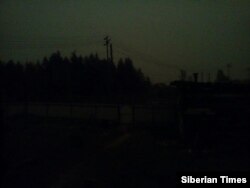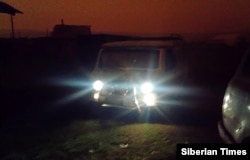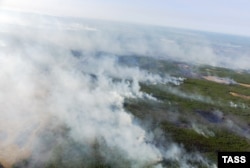In a part of Russia’s Sakha region, where the sun barely sets during summer, locals looked out of their windows around lunchtime on July 20 to a darkness so deep that many assumed an eclipse must have blocked out the sun.
But records show no occultation that day, and Siberia’s lively media scene is now humming with speculation as to what caused the hour of darkness across a swath of northeastern Siberia.
A local in Nizhne-Bytantaisky who asked not to be named told RFE/RL by phone that “around 11 a.m. on the 20th, the sky started to darken. It was as if a storm was approaching, but there was a yellowish tint. Then from 12 p.m. to 1 p.m. it went dark.... Then the sky began to brighten sharply.”
Around 200 kilometers away, another villager gave a local newspaper a slightly different timeline: “After lunch, around 2 p.m., it began to slowly darken. There was a slight stuffiness. No wind, no sun, no light. As if life had stopped. Some residents went about joking that the apocalypse had come.”
But not everyone was laughing in the dark.
Konstantin Starostin, a local official in Nizhne-Bytantaisky, told the Siberian Times that “when the sun vanished, people started calling us in the administration. Many people got scared, especially elderly people.”
Soon afterward, a cluster of 30 dead birds was discovered in the east of the same region.
A week later, theories of what caused the blackout range from the conspiratorial (Russia’s military testing a new weapon) to the biblical, but there is still no official explanation of what happened that day.
But with the region currently plagued by the wildfires that have become a regular summer crisis on the vast wooded expanses of Siberia, there’s one theory that may hold water.
Louise Fode, a meteorologist with the U.S. National Weather Service in Alaska, says the event was likely a freak convergence of multiple layers of cloud and smoke from forest fires. She tells RFE/RL that satellite images from the region on July 20 show a band of mid- to high-altitude clouds merging with “very dense smoke” from wildfires smoldering hundreds of kilometers to the south.
Additionally, Fode says a temperature inversion, a weather event in which a layer of cold air settles close to the Earth’s surface (inverting the usual rule of higher altitude equaling lower temperatures), could have caused the smoke to become more concentrated above the villages.
One well-known result of a temperature inversion is the air becoming “still and murky,” which may explain the ominous quiet described by locals.
In the region where the dead birds were discovered, a chill layer of air and the rain that often follows temperature inversions may also explain that mass death event. On July 20, the temperature dropped to 5 degrees Celsius in the region, cold enough to kill off weak or young birds. According to local reports, all 30 of the dead birds were fledglings.
Finding a similar example of day turning suddenly to night requires a look all the way back to the 18th century and the "Dark Day" of New England. It’s believed that smoke from forest fires blended with thick fog to completely block out the sun above Connecticut on May 19, 1780.
Smithsonian magazine reports that locals feared that Judgment Day had arrived, though not everyone lost their wits. Abraham Davenport, a member of the Connecticut legislature, reportedly peered out at the darkness and declared, “The day of judgment is either approaching, or it is not. If it is not, there is no cause of an adjournment; if it is, I choose to be found doing my duty. I wish therefore that candles may be brought.”












